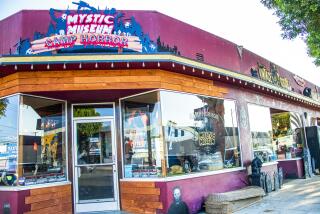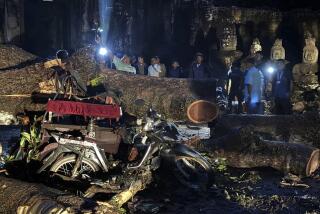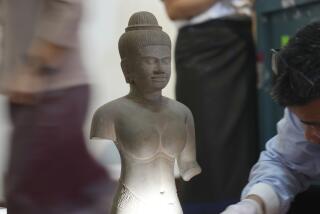Federal agents might seize Khmer statue
NEW YORK â Federal agents have threatened to seize from Sothebyâs a 10th century Cambodian sandstone statue, alleging the auction house planned to sell it despite warnings that looters had stolen the piece from its rightful place, adorning an ancient temple in the former Khmer kingdom.
Court documents filed Wednesday in New York say the statue of an ancient warrior was torn from the Prasat Chen Temple in Koh Ker in northern Cambodia sometime in the 1960s or early 1970s, when the Asian nation was engulfed in civil unrest. The statue fell into the hands of a private collector in Belgium, whose heirs reached an agreement with Sothebyâs to sell it on consignment last March.
Cambodia is the latest country seeking to reclaim ancient art looted from its soil and sold on the black market before surfacing in the United States. American museums, including the Norton Simon Museum in Pasadena, are home to thousands of Khmer objects with murky ownership histories that could be subject to similar suits if Cambodia seeks to pursue them.
Shortly before the Sothebyâs sale, Cambodian officials notified the auction house that the object had been looted, and the parties have been negotiating a settlement to the dispute for the last year.
Those negotiations ended abruptly Wednesday when the U.S. Attorney for the Southern District of New York filed a civil forfeiture suit, claiming the statue was stolen property under U.S. law.
âThe ... statue is imbued with great meaning for the people of Cambodia and, as we allege, it was looted from the country during a period of upheaval and unrest, and found its way to the United States,â Manhattan U.S. Atty. Preet Bharara said in a statement released by his office. âWith todayâs action, we are taking an important step toward reuniting this ancient artifact with its rightful owners.â
Sothebyâs disputed the allegations, saying in a statement that the statue âwas legally imported into the United States and all relevant facts were openly declared.â
In recent years, mounting evidence has emerged that American collectors and museum officials knowingly bought looted antiquities, ignoring national ownership laws of source countries and U.S. laws that treat such objects as stolen property.
Sothebyâs appears to have ignored similar warning signs, according to internal auction house emails cited in the court records.
âThe Cambodians in Pnom Penh now have clear evidence that it was definitely stolen from Prasat Chen at Koh Ker, as the feet are still in situ,â warned an American scholar who was studying the object for the auction house. âIt is also possible that the Cambodians might block the sale and ask for the piece back. ... I donât think Sotheby wants this kind of potential problem.â
The scholar later consulted with âculture spies and [a] museum directorâ in Cambodia and told Sothebyâs it was unlikely that the government would pursue a claim. Sothebyâs proceeded with the sale, with officials saying in internal emails that while it might receive bad press from âacademics and âtemple huggers,ââ the potential profits from the sale made it âworth the risk.â
The New York Times identified the scholar as Emma C. Bunker, an authority on Khmer art who has publicly defended the right of American collectors to buy objects with unclear origins.
There are frequent references in the federal complaint to another statue looted from the same site. Experts say it is a reference to a sandstone statue of a temple wrestler at the Norton Simon Museum, which the museum purchased in 1976 from a New York dealer and describes as coming from Koh Ker.
In a statement, the museum said it had not been contacted by Cambodia, whose officials have long known about the statueâs existence. âIn more than three decades of ownership, the foundationâs ownership of the sculpture has never been questioned,â said a spokeswoman.
That may soon change, experts say.
âOver the last decade, the climate has become much more favorable for Cambodia and other source countries seeking to repatriate looted antiquities,â said Tess David, an American attorney specializing in cultural patrimony law who is advising the government of Cambodia.
In a study of Sothebyâs sales published last year, Davis found that 71% of Khmer objects sold had no documented ownership history, suggesting they may have been products of the illicit trade.
More to Read
The biggest entertainment stories
Get our big stories about Hollywood, film, television, music, arts, culture and more right in your inbox as soon as they publish.
You may occasionally receive promotional content from the Los Angeles Times.











